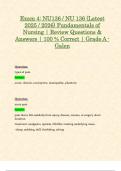Exam 4: NU136 / NU 136 (Latest
) Fundamentals of
Nursing | Review Questions &
Answers | 100 % Correct | Grade A -
Galen
Question:
types of pain
Answer:
acute, chronic, nociceptive, neuropathic, phantom
Question:
acute pain
Answer:
pain that is felt suddenly from injury, disease, trauma, or surgery. short
duration.
treatment: analgesics, opioids, NSAIDs, treating underlying cause.
-sharp, stabbing, dull, throbbing, aching
,Question:
chronic pain
Answer:
Persistent or recurring pain that is often difficult to treat. Includes any pain
lasting longer than 3 to 6 months, pain lasting longer than 1 month after
healing of an acute injury, or pain that accompanies a nonhealing tissue
injury.
-dull, constant, shooting, tingling, burning
-has many psychosocial effects: mental/stress, loss of work/job duties,
financial stress, poor sleep quality.
treatment: non pharmacological therapies and drugs (analgesics only for flare
ups)
-pain will never be 0, just needs to be manageable
Question:
nociceptive pain
Answer:
pain from a normal process that results in noxious stimuli being perceived as
painful
-sharp, aching, throbbing, pounding, cramping
-skeletal pain is deep and achy, cutaneous pain is acute and sharp
treatment: treat underlying condition, RICE, NSAIDs
,Question:
neuropathic pain
Answer:
pain from damage to neurons of either the peripheral or central nervous
system. nerve pain.
-burning, tingling, shooting, numbness, electrical shock
treatment: anticonvulsant, tricyclic antidepressants, capsaicin cream,
lidocaine patches, TENS unit, surgical release of compressed nerve, nerve
block
Question:
phantom pain
Answer:
pain felt in a body part that is no longer there/amputated. eventually
subsides.
treatment: same as neuropathic pain, electrical stimulation in the thalamus,
mirror box visual training.
, Question:
objective/subjective data of pain
Answer:
objective: visual assessment, functional impairment, timing of pain
subjective: pain level expressed (0-10), descriptions from pt, management
Question:
pain scales
Answer:
number scale, picture scale and NIPS (neonatal infant pain scale. always 0-10,
10 being worst pain imaginable). helps quantify pt baseline.
Question:
Pain Control: Nonmedicinal Methods
Answer:
Transcutaneous electrical nerve stimulation (TENS)
Percutaneous electrical nerve stimulation (PENS)
Binders
Application of heat and cold
Relaxation
Biofeedback
Distraction
Guided imagery and meditation




